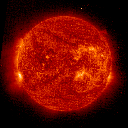Crabstock: I came upon a crab of God
 Crabstock. That's what it's like today at low tide. Hundreds of thousands of Soldier crabs (Mictyris longicarpus). As soon as you're within about eight paces of them, they hide into their holes and do whatever they do down there. Make love, not war, I guess. I hope they use protection or they could catch humans and other STDs.
Crabstock. That's what it's like today at low tide. Hundreds of thousands of Soldier crabs (Mictyris longicarpus). As soon as you're within about eight paces of them, they hide into their holes and do whatever they do down there. Make love, not war, I guess. I hope they use protection or they could catch humans and other STDs.
If you're more than pint-sized, looking down upon them is like being in a plane and looking down on Woodtsock. Then, when you've passed, they emerge eight metres behind you, so just by flaneuring along the strand at low tide you set up a kind of rhythmic or wave-like motion of the blue marbles-with-yellow-legs. They will do that for eternity, or until the seas are too polluted, whichever comes first.
You can almost outsmart them by turning around suddenly and stepping back a few paces, but it makes you look like Harpo Marx and people will talk, especially in a small village.
The beach at low tide is about 100 metres wide, and at any time it is a very flat landscape -- my guess is that across those 100 metres is a fall of only about a metre and a half. Over millennia the elements have pressed and blown into a flat runway the part of the sand that is not above the tidal limit. So when the tide's out, there's a big stretch of hard sand that a few people with far less consciousness than a Mictyris longicarpus confuse with a road. We refer, of course, to 4X4 carloads of dangerously obese tourists.
Today there were tyre tracks across the crabby patterns which, like constellations of the night sky, blaze gloriously along Sandy Beach, made by millions of tiny rolled balls of sand. And here's the rub: not only do the four-wheel-drive vehicle drivers (who, especially in summer holiday time, too frequently take a wrong turn onto a beach) make an ugly imprint on one of Nature's works of art. They also disrupt Nature's creatures. Scientific research indicates that the compression caused by the lost cars and their heavy, grinning occupants, damages the crabs' ecological niche. It's not really so hard to work that out, is it?
There are ways to reduce significantly the numbers of 'recreational' vehicles, and the florid-faced families that grin from them, that don't actually require the excavation of very large sandtraps, though these are perfectly acceptable. We'll be returning to this topic some time in the future, with some fun methods of SUVicide. Ooooh yes indeedy we will!
Today I think I heard the crabbies singing, half a million strong:
"We are stardust, we are golden, we are billion-year-old carbon ..."



















0 Comments:
Post a Comment
<< Home